Crazy vul: ideas for using this technique in everyday life.
Crazy quilt technique in the interior. Crazy vul - master class
I continue publishing on the topic of crazy techniques. I'm somehow hooked on her))) Magic technique crazy - creativity for brave people. The works done using this technique amaze with their colors, talent and audacity of the craftswomen. This is where there is room for imagination. Usually I include a list of necessary materials for master classes, but here, in publications for crazy, you can write: necessary materials- ALL! Full “drive” and production according to a “crazy” recipe)
Did you know that this technique is divided into two types? Crazy Wool and Crazy Quilt, the latter is more like patchwork and is translated as “crazy scrap”) I just don’t know what kind of “crazy” he is))) because the scraps are assembled according to a strictly defined pattern.
So, maybe someone is not familiar with technology? general review and a master class on Crazy Vul.
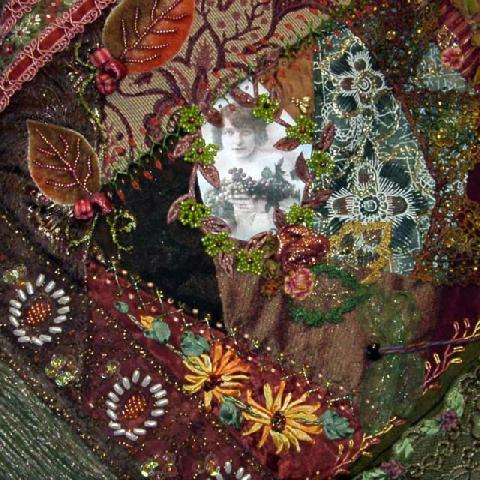


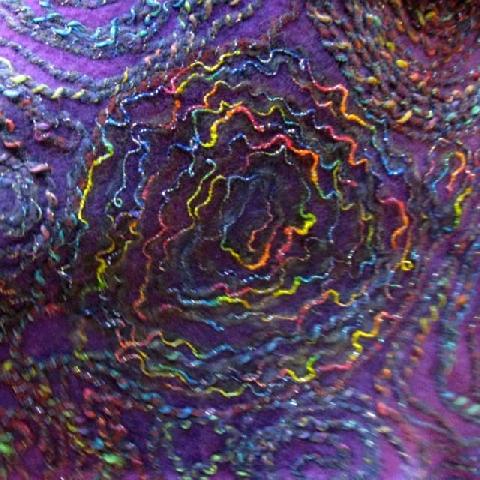
![]()
As you can see, the name “crazy” says it all. Incompatible fabrics are connected, sewn together in unimaginable combinations. And they are sometimes decorated with decors that are incompatible with each other. Everything here works to impress. Things made using the crazy technique will not leave anyone indifferent.

How can you apply this energetic, fun technique to your interior? Whatever! A few sofa pillows, a tablecloth, and a blanket thrown over the sofa will transform, enliven the room, give it dynamics and rejuvenate it. From looking at such things, each of which is unique, the mood inexorably moves up the scale. Therefore, the crazy technique is appropriate in the living room, in the nursery, and in the kitchen. Maybe it's only in the bedroom that incendiary accessories are inappropriate.
Things using the crazy technique have a hint of negligence. But only to the level of dynamics, far from carelessness. Even if there are pieces of fabric sticking out and threads hanging down, it all looks very organic. Do you know why? Because each accessory is created in more than one hour. A lot of creativity and work goes into even the smallest item. Every stroke and spot of color is thought out and not thrown carelessly. Craftswomen use all their knowledge. Look - there is quilling, patchwork, felting, embroidery, painting, and kanzashi...
We'll figure it out right away. There are two subspecies:
crazy quilt - “crazy patchwork”, closer to patchwork.
crazy vul.
Crazy simply could not help but arise, because there had to be a counterbalance to the strict geometry of classical quilling. Great technique, variety of colors and limited movement. Bright shreds are assembled according to a strictly defined pattern. One day, this predestination drove someone crazy, and their soul rushed to heaven!
Crazy Wool is a “crazy thread”, closest to felting. Things are made using these techniques in ways that have nothing in common with each other. But how, how is this done?


Crazy quilt technique Making the first pillow, or rather a cover. General principle is this: we cut out the details, focusing on the photograph. Sew four identical squares. This will be the outside of the case. And we customize the decor with a completely arbitrary line. The freer she is, the more beautiful she is. It’s better to make several of these pillows in different color ranges, but maintaining the overall pattern. Sew as you want...

Master class of crazy vul technique
We make fabric from threads. There are two ways. Both have been tested by craftswomen, both are very interesting to make. Shall we try?
Both methods require threads - knitting yarn, lurex, pieces of cords, braids and everything beautiful and interesting that you can find at hand. For one of them, a water-soluble base is required - a special interlining or film. They can be found in craft stores.
Iway. We cut out two identical pieces of the same format as the intended fabric should be. We select yarn of one or several colors, similar or contrasting shades, depending on the design. We cut into pieces cords, braid, brocade, everything that will serve as decoration inclusions. Spray the base generously with a temporary hold spray or just strong hold hairspray.
Differences in functionality in this case no, but the difference in money is noticeable. Now we turn on the music necessary to create the appropriate mood. And carefully place it on water-soluble film or non-woven threads. Having created the first layer in a free order, we place the decorative pieces. We continue this until we have almost covered the entire area. This is where there is room for flight of fancy!
When the level of chaotic beauty is quite pleasing to the eye and soul, spray everything again with hairspray and cover with a second piece. The varnish in this work plays the role of a light glue, so everything needs to be done quickly so that it does not have time to dry. As a result, we got a sandwich like this. All that remains is to stitch it.
Thread the sewing machine with silk thread and make stitches from edge to edge. Be careful not to move the film. You can quilt in small squares, like a quilt, you can stitch in diamonds, zigzags, whatever you like. Special attention- edges of the product. But remember that the film is the frame, the lattice on which everything rests. If it is not tight enough, everything will crumble when the base is removed.
Progress on the crazy-wool fabric:


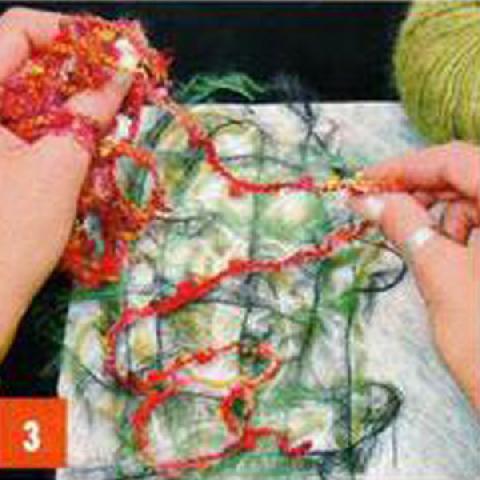
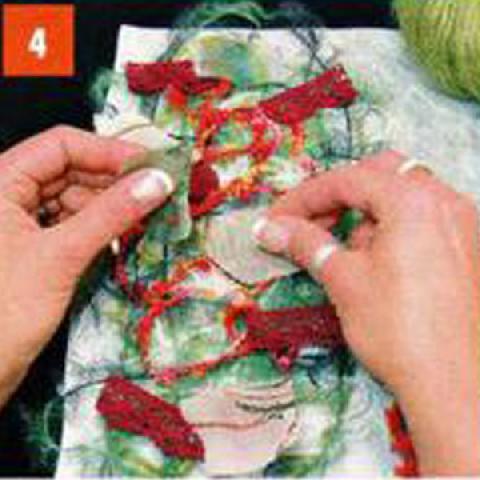


When the density of the lattice is sufficient, we move on to the most interesting part. We immerse our miracle in a basin of warm water and begin to knead it and rub it to help the non-woven fabric or film dissolve. This will take a few minutes. All that remains is to rinse in clean soft water and dry as knitwear is dried: lightly wrung out and laid out on a towel or terry sheet. And here it is - the result! 

II method will come in handy if you don’t find a water-soluble base in the store. The craftswomen came up with the idea of using regular thick film and wallpaper glue. And they use it quite successfully!
The process is the same. Thick film or oilcloth does not need to be cut. It should be larger in size than the expected size of the product. Spray it with varnish and begin laying the threads, as in the first method. When everything is ready, dissolve the wallpaper glue instant cooking. And with the help foam sponge thoroughly saturate all the work. This should be done with blotting movements. Under no circumstances move the sponge left and right - this can move the threads and ruin the work. When the threads are saturated with glue, you need to give the glue time to dry. This may take several hours. Then we remove the work from the oilcloth backing and stitch it exactly as in the previous version. Nothing complicated!
And, at the end, we bathe our masterpiece in warm running water until all the glue is washed off. Wring out and dry.
Fabrics made using the crazy wool technique will be an excellent decor for pillows, photo frames, lampshades, covers for plant pots, and independent panels. It all depends on what threads you use. Good luck to you and the flight of your soul!
![]()
Author of the article Elena Bessmertnaya
Source http://ibud.ua/ru/statya/tekhnika-kreyzi-v-interere-100885
Products made using the Crazy Wool technique from the book Crazy Wool
Crazy Wool- a technique for creating things (clothing, accessories, paintings) from wool yarn, but without knitting.Etymology
Crazy Wool– from English words, meaning “crazy wool” or “crazy yarn” (in Russian it sounds like “crazy wol”). Among Russian needlewomen the technique is called “ crazy thread" But technology has another name - sandwich, which in translation means “sandwich” (sandwich) and fully reflects the essence of the method - layering threads on top of each other.
Items made using the Crazy Wool technique are sometimes called " lazy- “lazy sweater”, “lazy scarf”. In the sense that knitting skills are not required to create a product, and you can simply throw on threads layer by layer, thereby obtaining a “knitted” item for several hours.
Method
Crazy Wool allows you to make real woolen items (such as scarves, collars, vests and even sweaters and dresses) without knitting skills. More likely, you need sewing skills on a sewing machine rather than crocheting or knitting.
Crazy Wool is sometimes mistakenly called a felting technique. But Crazy Wool has a fundamental difference: things do not shrink in size, they do not need to be washed and felted, but just wet to dissolve the stabilizer film. Although preparing the product is similar to “wool painting” - the patterns are born in the same way, layer by layer.

Canvas using the Crazy Wool technique, but not only from threads, but with scraps of fabric and braid
Sometimes the base is not a stabilizing film, but a fabric or mesh; they do not dissolve in water and become the bottom layer or background. But a water-soluble film is still needed; it holds the threads on top. In this case, the thing turns out not openwork, but rather dense. This principle is used in the manufacture of bags, paintings, and any durable things.
There is a variation of Crazy Wool, in which not threads are used, but scraps of fabric, lace, and braid. The principle of operation is the same, but it is more of an appliqué than a real “knitting without knitting.”
Materials for Crazy Wool

Desktop and Crazy Wool product
- Any threads for knitting, you can use leftovers, threads will do different thicknesses and completely different textures.
- Wool for felting.
- Scraps of fabric that can be woven into a pattern.
- Sewing threads to match the main color of the future product.
- Water-soluble stabilizer for embroidery. In appearance, this is a translucent fabric, similar to matte cellophane film. Sold in craft stores.
- Spray fixative for embroidery or wool painting(available at craft stores) or strong-hold hairspray.
Stages of work
1. A stabilizer of the required size is taken - according to the size of the future product. If the product has complex shapes, then the stabilizer should be cut according to the pattern (for example, when making clothes). Place the stabilizer on the work table.
2. Spray the stabilizer fixative.
3. First layer of thread. The threads of the first layer are laid out on the stabilizer in a chaotic order.
4. Second layer of thread. It is laid out similarly to the first one. If you are planning a pattern, then you can already start laying out the threads of the desired color.
5. The third and subsequent layers of thread. You should continue to “fill” the “sandwich” in accordance with the selected pattern or color scheme. Depending on the complexity of the design, a different number of layers may be required. For example, for a simple openwork scarf you will need 5 layers of thread.
6. When the pattern is laid out with threads, it should be secured with a fixative or hairspray. It is important to make sure that the threads fill all the voids and that the openwork is not too large.
7. Cover the product with a layer of stabilizer on top.

"Crazy wool" - a "lazy" sweater.
No time to knit? And with sewing "for you"? Then the “crazy wool” technique is something that will be interesting to you. With this technique, the yarn consumption for a sweater is reduced by 4-5 times (for example, my hamster supplies are full of leftover yarn. It seems a pity to throw it away and you won’t be able to knit anything).
And also, this method is a salvation for people with hypersensitive skin (which I have the misfortune to relate to (my skin cannot tolerate the touch of fur - everything pricks and itches).
The author of this technique is Jeannette Knake. A couple of years ago I came across her books, and, as is my habit of grabbing everything related to needlework, I bought them. The technology is very interesting, but buying books turned out to be a translation, because the principle of making all things is the same, you could read it in a store, you wouldn’t miss anything).
The basis of the whole process is water-soluble interlining and temporary adhesive spray. I used primitive patterns, like knitting, although, in principle, you can make things of any complexity of cut. Jeannette recommends laying the yarn between two layers of water-soluble, but I don’t really like the “holes” between the threads, so I laid the threads on silk (you don’t have to use silk, you can lay it on any fabric, but silk is more pleasant to put on))). The fabric was drawn with chalk into even stripes, so that when laying out the yarn, one could be guided by them and not warp the rows. Then I sprayed the fabric with spray and laid the yarn in rows (you can do it in an artistic mess, but in this work I did it in rows). Be careful with the spray - it tends to put “blots” on the silk, then they don’t wash off. I tested different kinds glue, I didn’t notice much difference. You can lay it out immediately according to the cut out pattern, this will save fabric, but will add headaches with edges (zigzag processing or overlock). In this model, I tucked the edges under the knitted patchwork.


Silk is very slippery, so to prevent the fabric from moving, I pulled it with pins onto the travel foam.
Once again I sprayed the spray on top and pressed the water seal. I drew it out in advance with a simple pencil, outlined future lines.
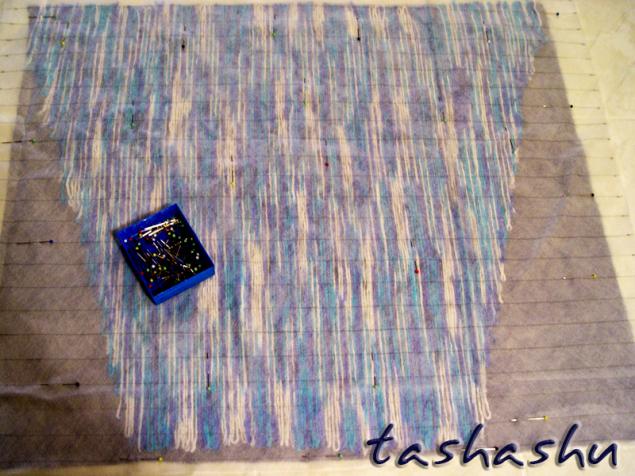
I secured the entire “structure” with pins. It is not for nothing that the spray is called “temporary”; the gluing effect decreases quite quickly and, during the quilting process, the interlining is held mainly by pins. We have a “sandwich”: fabric - yarn - water-soluble interlining.
I stitched on the machine along pre-marked lines across the laid out rows of yarn.
![]()
On the finished canvas (silk backing), I drew a pattern with chalk and laid a line along it, then cut it out and finished the edges with a zigzag.
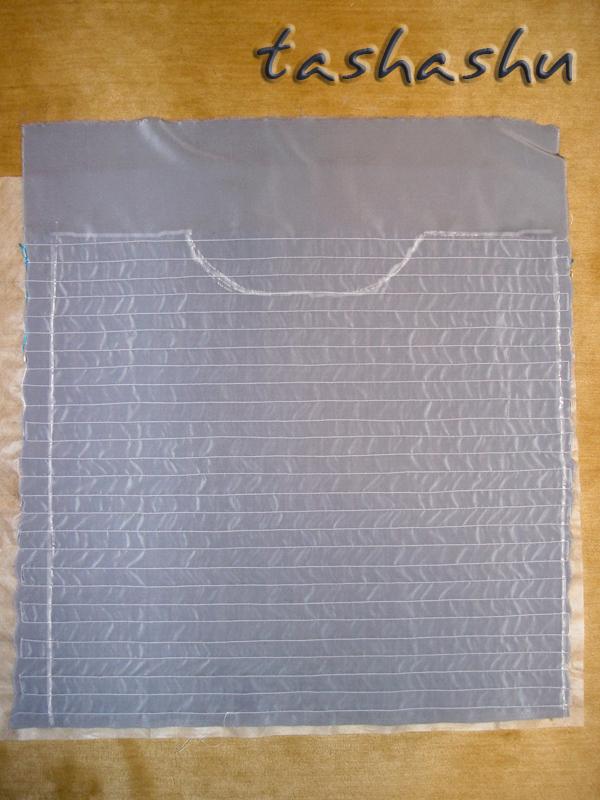

I dissolved the interlining with water. It is better to soak for a while and then rinse under pressure.
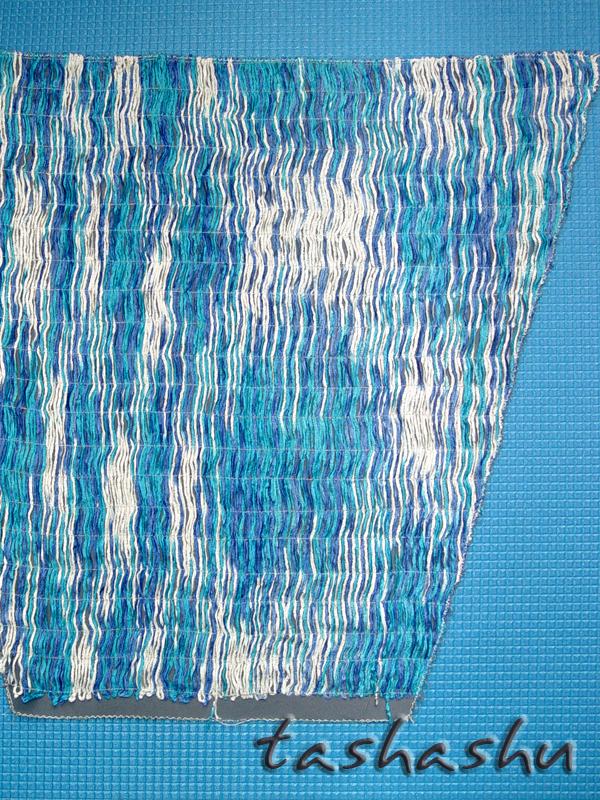
That's all, actually). The sweater is sewn. In this model, the edges are decorated with knitted patchwork, the cuffs and collar are decorated with elastic.
Oh, I almost forgot... It is always very difficult to perfectly and accurately sew a knitted piece to the fabric. Here I used this method: on the fabric, along the line of connection with the future knitting, I first laid a large machine stitch, and then, already on it, using a hook I picked up the first row of knitting. Then knit as usual. The junction is very neat. And from the inside it is convenient to knit a small strip using the same method; From the same line (wrong side), pick up loops and knit a couple of centimeters, close the loops and hem to the main collar. So a piece of fabric was neatly hidden on the reverse side.


Municipal budget educational institution average comprehensive school
With in-depth study individual items No. 29
PROJECT
Products using the crazy vul technique
(lazy knitting)
Performed: Borisova Yulia
11th grade student B,
project Manager
Borisova Elena Sergeevna
technology teacher MBOU secondary school No. 29
Georgievsk 2014
Content
Historical reference ………………………………………….. ….3
Justification of the project…………………………………………..….……...6
Variability……………….…………………………....…....... ….9
4. Safety precautions…………………………….…..……………10
5. main part………………………………...…………… ………...11
6.Economic and environmental justification…………………….14
7. Conclusion……………………………………..………..………16
8.Advertising…………………………………………………………….…………………..17
9. List of used literature……………….. ………………...18
10.Photo of the product……………………………..……………….19
Historical reference
History of "Crazzy Wool"
The history of the Crazzy Wool technique is very young, no more than five years old.
The author of this amazing technique is the no less amazing and talented Jeannette Knacke, who acts as a magical wool artist.
Jeannette Knacke is the author of many techniques that open up new possibilities for working with yarn.
For example, creating soft paintings with your own hands. These paintings are unusually soft, calm, incredibly cozy and homely. But they are completely different
Thanks to Jeannette Knacke, the fascinating technique of felting and felting wool is becoming more and more popular. In it you can create both simple paintings and toys, and expressive wall panels. Jeannette became the author of a book that opens up new opportunities for readers in working with artistic felt.
Jeannette's piccolin technique is a new knitting method that uses small pieces of fabric to achieve a breathtaking effect! By tying lace or organza, ordinary smooth yarn becomes a very unusual texture.
And the Miracle Patchwork technique acquires from this author completely new life and is completely different from classic patchwork. These are not just rugs and bedspreads, but exclusive ones. Models and accessories in this technique are incredibly fashionable and modern.
And after reading the book “Miracle Wool”, you will replenish your wardrobe with unique outfits and accessories for every taste and season.
It is not surprising that such a creative and versatile person as Jeannette Knacke invented the technique and then wrote the book “Crazzy Wool”. It presents models of clothing and accessories that can make your style unique and unique. Completely new opportunities open up for you in the manufacture of original clothing! Now, even without knowing how to knit, you can create warm clothes from yarn without knitting needles or a hook, simply by laying the threads on water-soluble interlining and securing them with machine stitching. Such products are distinguished by their individual, bright and varied design. Thanks to step-by-step descriptions, supplemented with patterns, and useful tips you can easily master this type of needlework.
The Crazzy Wool technique combines well with other techniques, as well as with embroidery (ribbons, threads, beads), crocheting, dry and wet felting etc.
Crazy style vul.
Technology capabilities
Do you know that this Crazy vul technique divided into two types? Crazy vul And crazy quilt, the latter is more like patchwork and is translated as " crazy shred"
The main thing in this technique is its aesthetic side. Uniqueness and unpredictability, unlike anything else famous technicians. This is complete madness in a good way this word!
Crazy goes very well with embroidery (ribbons, threads, beads), crocheting, wet and dry felting. Then everything depends on the author’s imagination.
In general, this is the creation of fabric from yarn and other sewing materials. You can create fabric from knitting threads, add pieces of beautiful scraps, lace, ribbons and all sorts of other goodies. for creating things using the Crazy Wool technique!
Things in the wash behave much better than knitted ones - they don’t get deformed! They are washed in the same way as knitted models, only unlike knitted ones, these can be hung!
And great to wear! I read about some fears that these things can be “caught” on the subway or somewhere else, but girls, excuse me, so what? knitted or crochet? So wear it in good health and wash it calmly.
As you can see, the name “crazy” says it all. Incompatible fabrics are connected, sewn together in unimaginable combinations. And they are sometimes decorated with decors that are incompatible with each other. Everything here works to impress. Things made using the crazy technique, will not leave anyone indifferent.
The Crazy Wool technique (“crazy thread”) is for people who love to create and (or) wear hand-made things. It is impossible to repeat the drawing. Complete exclusivity and exquisite originality. , and very affordable price we offer on this site!
Selection and rationale
Desperate beauty when creating clothes is achieved not only by enormous labor costs. Modern technology"crazy vul" allows you to embody the most unusual ideas. Moreover, for work you can use both water-soluble non-woven fabric and other options. Craftswomen have already appreciated all the advantages of the technique, thanks to which fantastic patterns are applied very easily - and, moreover, can form the basis of the product.
Magic crazy vul
Thanks to the crazy vul technique, you can easily see how sophisticated and elegant the most ordinary things become. Stoles, capes and scarves, elegant items for the wardrobe of any beauty, are created thanks to a combination of the warp, which is then removed, and the unusual arrangement of threads - which can intertwine, meander through the product and create the most bizarre patterns.
Where else will technology come in handy? ? Of course, when creating paintings and interior products, decorations of any kind. However, the “squeak” is large products with a straight cut. A simple coat that would not arouse interest among others, made using this technique, becomes a wonderful gift for yourself. unusual thing in wardrobe.
Interior solutions and features of "crazy vul"
In the interior, products made using this technology look very fun and unusual, creating a feeling of comfort and softness. Expressive pillows, tablecloths, napkins, blankets or bedspreads, and delicate items will decorate any room. The products allow you to diversify the interior of your living room, kitchen or nursery. Almost all options for using technology have a right to exist - and it is very easy to make the thing you want, fantasy and unusual, using this technique.
Characteristics style - some negligence and asymmetry. However, these things are cute, dynamic, and always amaze with their attention to detail. Every item shows that a lot has been put into it. manual labor, fantasies of a craftswoman.
Ideas: what can be done using the Crazy Wool technique
A large number of ideas can be gleaned from handicraft forums and handicraft blogs. A special book “Crazy Wool” has been published, containing instructions and models of clothing that are made using this interesting technique.

Products made using the Crazy Wool technique from the book Crazy Wool
For beginners, we can advise starting with simple rectangular things: a scarf, a picture, a bag, a collar, for the interior. More advanced needlewomen make using the technique.
At online auctions, needlewomen offer their items for sale. For example, at an etsy.com auction. There you can get a lot of ideas for scarves, vests, and dresses.
In the women's RuNet there are communities where you can find photo galleries with products using the new Crazy Wool technique, posts with tips, and master classes. For example, such communities exist in in social networks(Facebook. LiveJournal, LiveInternet), women's social networks (MyJulia.ru) and on handicraft forums ().

How can you apply this energetic, fun technique to your interior? Whatever! A few sofa pillows, a tablecloth, and a blanket thrown over the sofa will transform, enliven the room, give it dynamics and rejuvenate it. From looking at such things, each of which is unique, the mood inexorably moves up the scale. Therefore, the crazy technique is appropriate in the living room, in the nursery, and in the kitchen. Maybe it's only in the bedroom that incendiary accessories are inappropriate.
Things using the crazy technique have a hint of negligence. But only to the level of dynamics, far from carelessness. Even if there are pieces of fabric sticking out and threads hanging down, it all looks very organic. Do you know why? Because each accessory is created in more than one hour. A lot of creativity and work goes into even the smallest item. Every stroke and spot of color is thought out and not thrown carelessly. Craftswomen use all their knowledge. Look - there is quilling, patchwork, felting, embroidery, painting, and kanzashi.
Variability




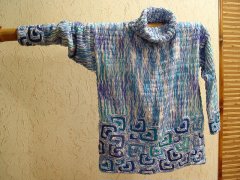


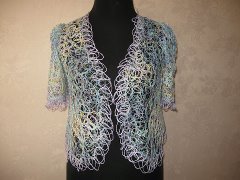
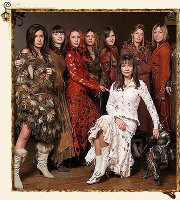
Safety instructions
when performing manual work (sewing, embroidery, knitting)
1. Safety requirements before starting classes
1.1. Store handicrafts in a special pencil case or box.
1.2. Store needles and pins in a pincushion.
1.3. Do not bring to class a large number of needles and pins.
1.4. Do not bring scissors to class.
2. Safety requirements during classes
2.1. Treat your work and work tools with care.
2.2. Do not put needles, pins, knitting needles or hooks in your mouth or stick them into clothing.
2.3. For sewing and embroidery, thread the needle no longer than your elbow.
2.4. During a break in work, stick needles and pins into the needle bar, place the scissors on the table with the blades closed.
2.5. Pass scissors to each other only with the blades closed, rings facing forward.
2.6. Be careful not to let the scissors fall on the floor.
2.7. Do not bite the thread with your teeth or tear it off with your hands.
2.8. When working with needles, use a finger thimble.
2.9. Do not swing scissors, knitting needles or hooks.
3. Safety requirements in emergency situations
3.1. In the event of an emergency (fire, etc.), leave the office as directed by the teacher in an orderly manner, without panic.
3.2. In case of injury, contact your teacher for help.
3.3. At feeling unwell or a sudden illness, notify the teacher.
4. Safety requirements after classes
4.1. Check the number of needles and pins in the needle bar; there should be the same number as there were at the beginning of work.
4.2. Wrap broken needles and pins in paper and throw them in the trash.
4.3. Place scissors, knitting needles and hooks in a specially designated place.
4.4. Put your work away in your purse or work box.
4.5. Bring yours workplace in order
Main part
Materials for Crazy Wool

Desktop and Crazy Wool product
Any threads for knitting, you can use leftovers, threads of different thicknesses and completely different textures will do.
Wool for felting.
Scraps of fabric that can be woven into a pattern.
Sewing threads to match the main color of the future product.
Water-soluble stabilizer for embroidery. In appearance, this is a translucent fabric, similar to matte cellophane film. Sold in craft stores.
Sewing spray for embroidery or wool painting (available at craft stores) or strong hold hairspray.
Routing
№ p/p
Operation description
Materials and equipment
1
This is a set of yarn for a poncho. And the poncho itself will consist of two rectangular canvases measuring 50*90cm.

2
Cut out 4 rectangles measuring 50*90cm from water-soluble non-woven fabric. We take one of them and make a kid-mohair layout on it. We “draw” an openwork fabric with yarn. Carefully lay the yarn along the edge.
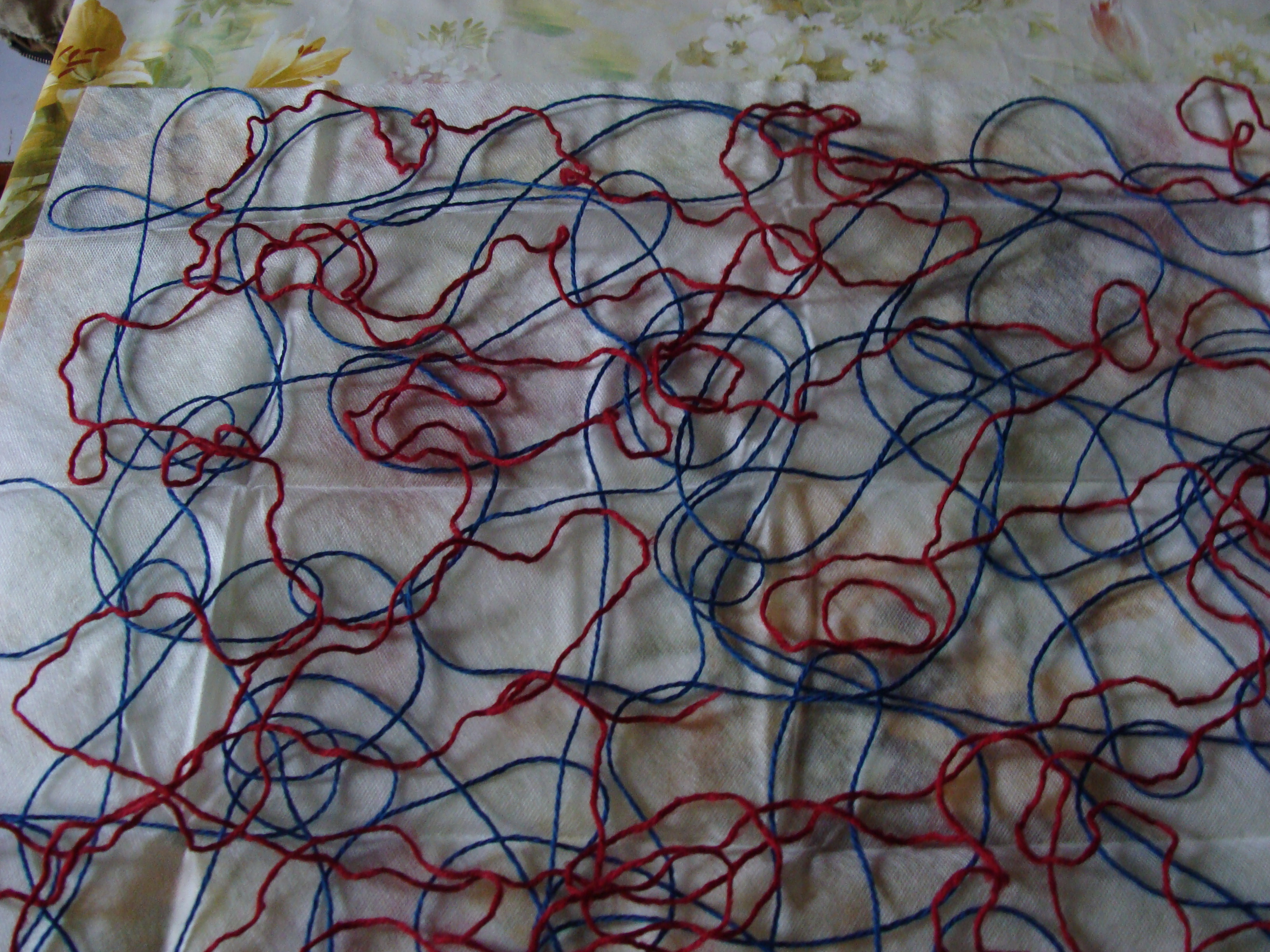
Water-soluble interlining, yarn
3
Fill the rectangle with kid mohair. All four edges look like neat scallops.

Water-soluble interlining, yarn
4
We cover our “picture” with a second non-woven rectangle. I pin along the perimeter, and then lay running stitches with contrasting threads at intervals of 5-7 cm, capturing the centers of the flowers.

Water-soluble interlining, yarn
5
And then we sew this entire “sandwich” on a sewing machine. First, we lay a stitch along the entire perimeter, and then with 2*2cm squares, each time clinging to the perimeter stitch. Or you can stitch with diamonds or randomly (at the discretion of the master). I work with different sewing threads. In this case, I stitched with monofilament. You need to make two such paintings, absolutely identical. After stitching, place the blanks for the poncho in cold water, the non-woven fabric dissolves (the water must be changed several times or washed under running water in the sink). Wash with shampoo, dry and sew.
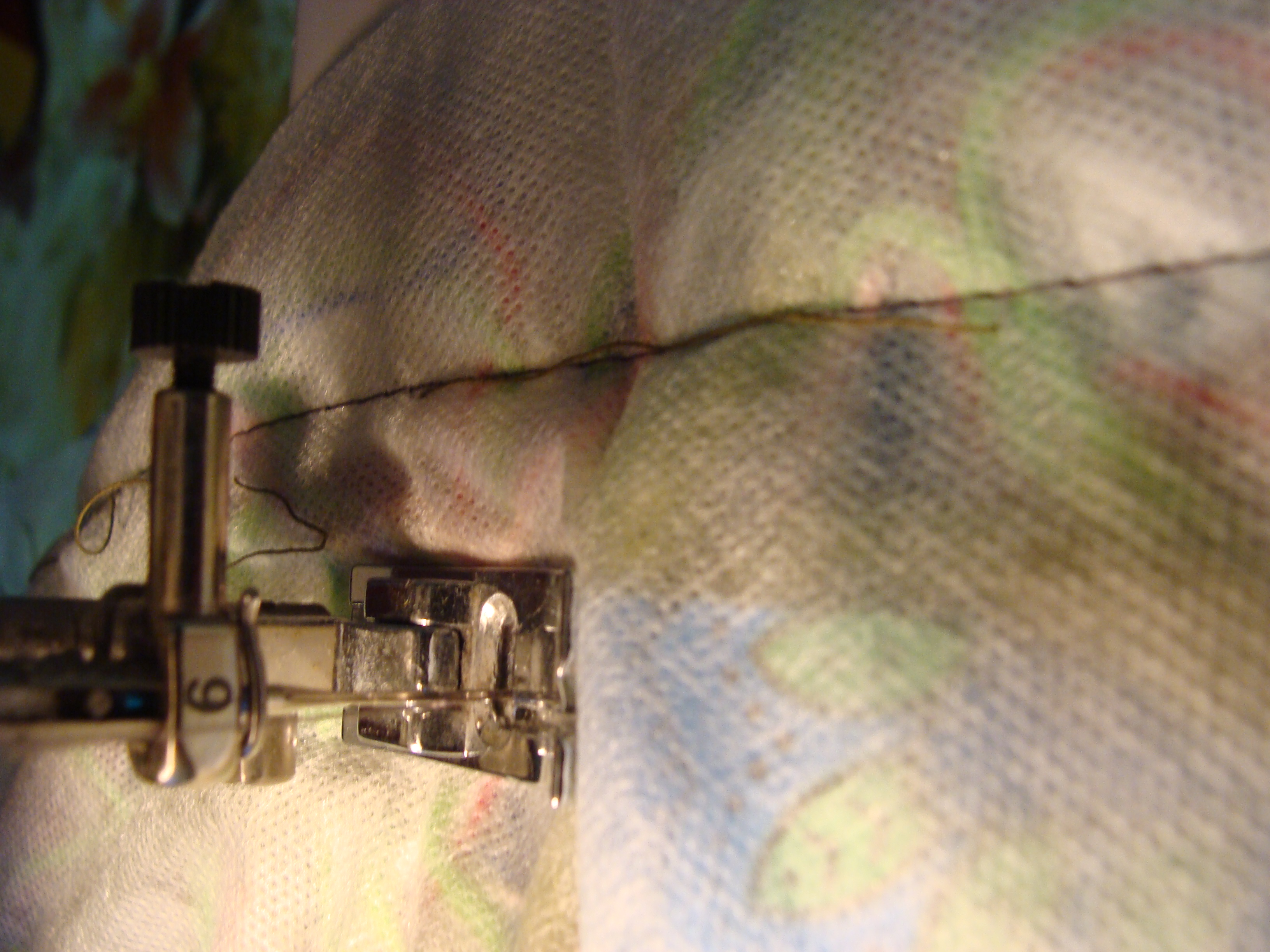


Water-soluble interlining, yarn, sewing machine, scissors
Ecological justification
In the manufacture and operation of my product, materials were used that do not pose a threat to human life and environment. The product is environmentally friendly.
Advantages of natural wool: none artificial materials will not replace the beauty and warmth of natural wool. Wool heals a person and fills him with vital energy.
Economic justification
The product has a low cost and costs 2.5 times less than in the store. The cost does not include the cost of work, since it was made independently, therefore project work economically beneficial. I have never seen such a set ready-made, it is knitted beautifully and of high quality.
Material
Price
Consumption
Expenses
Water-soluble interlining
240r(90*100)
2 pcs
480rub
Yarn
leftovers
Total:
480rub
Aesthetic justification
The main thing in this technique is its aesthetic side. Uniqueness and unpredictability, unlike any other known technique. This is complete madness in the good sense of the word.
Self-esteem
I think it was not in vain that I did this great job and chose this type of work as knitting, since I learned how to knit well, how to knit different elements and patterns. I also became acquainted with some concepts that I did not know before, safety precautions. While fulfilling my goal, I never once regretted taking on this job. At first I wanted to cross-stitch a picture, but I thought: why don’t I develop my abilities and try to do a different type of work. And I even really liked it. I think that you shouldn’t always stand on one thing, but always try something new, because in later life it won't hurt. This type of work creative project I liked the technology, and I think I need to think about choosing my future profession.
Like mushrooms, new techniques arise and are improved. And that's great. There should be classics, this is natural, but new directions should also develop. Products made from non-woven fabric have long been included in the category of fashion trends.
Crazy simply could not help but arise, because there had to be a counterbalance to the strict geometry of classical quilling (see article ). Excellent technique, variety of colors and limited movement. Bright shreds are assembled according to a strictly defined pattern. One day, this predestination drove someone crazy, and their soul rushed to heaven!
Crazy Wool is a “crazy thread”, closest to felting. Things are made using these techniques in ways that have nothing in common with each other.
Crazy wool - interesting new technology for people endowed with imagination. A chaos of threads that are different and seemingly incompatible turns into finished products into the miracle of the picture. Products using this technique only require a little inspiration. Because by connecting threads you create a material that you can also further refine like regular fabric.
Advertising
If you really like to look original, appreciate handmade And creativity in clothes, accessories and interior design, and at the same time you do not know how to sew and knit, or you know how, but do not have enough time for painstaking creativity, then you will definitely contact the address. Georgievsk, st. Schastlivaya, 5, tel. 8928-777-7777.
http://www.supermaggie.com/thingstobuy/?merchandise/Scarves
Product photo

We present a gallery of works by Natalia Shmigelskaya. The master works using the most interesting Crazy Wool technique, which is now rapidly gaining fans all over the world.
Crazy Wool - “Crazy thread” - this is how the name of this amazing technique is translated. And indeed, only slightly “crazy” craftswomen can create Crazy Wool things! After all, here Her Majesty Fantasy takes everything into her own hands.
Crazy-wool is a kind of drawing with yarn. This is creativity. And in the process of work, the master can repeatedly change initial plans. We started making “morning freshness”, but what we got was “midday heat”. 🙂
One thing is clear: a thing made using the Crazy Wool technique will arouse the genuine interest of your friends and the envy of your rivals. Surely you will be asked more than once to take off your scarf (jacket, stole) in order to examine, stroke, touch and ask: “How was this made?!”
And you will smile mysteriously and...
All items presented in the gallery can be ordered. The master will take into account all your wishes (colors, size, style, additional decorative elements, etc.)
The price depends on the cost of consumables and the complexity of the model.
So, we give the floor to the master - Natalya Shmigelskaya.
Vests and jackets
Vests are a different story! I dream of creating my own “Vest Collection”. Agree, the vest looks great with jeans, a skirt, and trousers.
Remember famous movie « Love affair at work"? There, the secretary Verochka (Liya Akhedzhakova) wears these “squeaky vests.” But this fashionista knew what a real woman should be like!
The vest is a piece of clothing that never goes out of fashion, so it will always appeal to all generations.
1. Vest “Reeds”
Size 46-48. Sewn using the Crazy Wool technique. Season autumn – winter.
Very warm. Yarn: angora, acrylic, wool and ribbon (fancy yarn).
The bottom and neck are not specially processed - a “ragged effect” is created.
Personally, I love the Boho, avant-garde style... and yes... I love ripped!
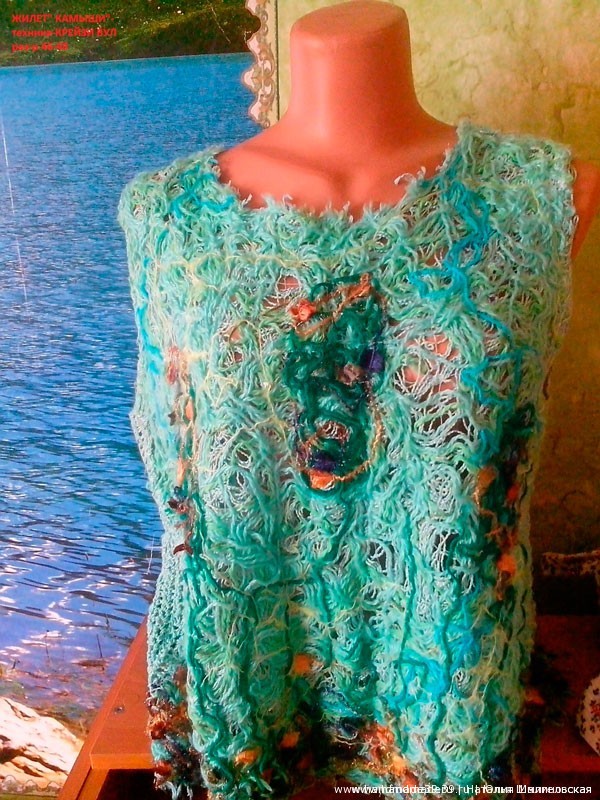 Vest "Reeds".
Vest "Reeds". 2. Vest (bolero)
Size 46. Short. Knitted from very warm Furlana yarn + angora, wool. Season – spring, autumn.
The Crazy-wool technique allows you to make products from such yarn (very warm) with gaps (light openwork). This provides additional ventilation and, accordingly, additional wearing comfort.
 Warm vest made from Furlana yarn.
Warm vest made from Furlana yarn. To order will cost from 2500 rubles(excluding postage) and depending on length, size. The fairly high price of the product is associated with the high price of Furlana yarn. But the result will not disappoint you!
3. Bolero “Sky Blue”
Size 46-48. Crazy vul technique. Blue color.
I really love the color blue, it is always present in my wardrobe. Maybe because according to my horoscope I am a Pisces. I'm drawn to sea colors!
4. Jacket “Delicate flowers”
Size 46-48. Made using the Crazy Wool + knitting technique. Yarn: cotton, iris; guipure and fabric (cotton); drawing - flowers with petals.
The back is knitted - mesh (acrylic). Season: spring. Very bright blue color.
 Jacket “Delicate flowers”.
Jacket “Delicate flowers”. For sale or (if already sold) I’ll create something even better.
5. Jacket “Filigree”
Size 46-48. Season spring – summer. Materials: microcorduroy fabric, yarn, felting wool, braid, lace (guipure). Ethnic elements (filigree).
 Jacket "Filigree".
Jacket "Filigree". Can be made to order in any color. It looks very unusual.
6. Bolero “Wedding”
Size 46–48-52. Material: cotton. Openwork.
 Bolero “Wedding”
Bolero “Wedding” Additional decoration with beads is possible. The bolero will go perfectly with any dress. Price 1300 rubles.
Tops and tunics
1. Summer top “On the sand”
Size 46 – 48. Crazy vul technique. Season spring – summer. Yarn: cotton, viscose; denim inserts. Sand color.
Looks good with jeans and summer trousers. The silhouette is slightly flared.
The top is thick, although it is made of cotton. However, it's not hot in the top!
 Top “On the Sand”.
Top “On the Sand”. Can be repeated to order (in any color scheme).
2. Top tunic “Forest mystery”
Made using the Crazy Wool + knitting technique. Size 46 – 48. Season: spring – cool summer. Materials: acrylic, viscose, grass yarn, twig pattern. Color transitions: green – blue – dark blue.
The back is knitted (loin mesh).
The tunic is also suitable for expectant mothers: slightly flared.
 Top tunic “Forest mystery”.
Top tunic “Forest mystery”.  Loin mesh on the back.
Loin mesh on the back. 3. Top tunic for girls “Mesh”
Knitting - fillet mesh. Material: cotton. Flower applique using the Crazy-Vul technique.
For a girl 3–4 years old.
Can be worn on naked body or like a vest.
Made to order. Any color scheme and applique of the customer's choice. An option for a boy is possible (drawings using the Crazy Wool technique).
 Mesh tunic for the little fashionista.
Mesh tunic for the little fashionista. 
The price depends on the complexity of the work and the material.
4. Top tunic “Forest”.
Size 46 – 48. Crazy-wool technique (and the back too). Grass yarn gives the effect of green branches in the forest.
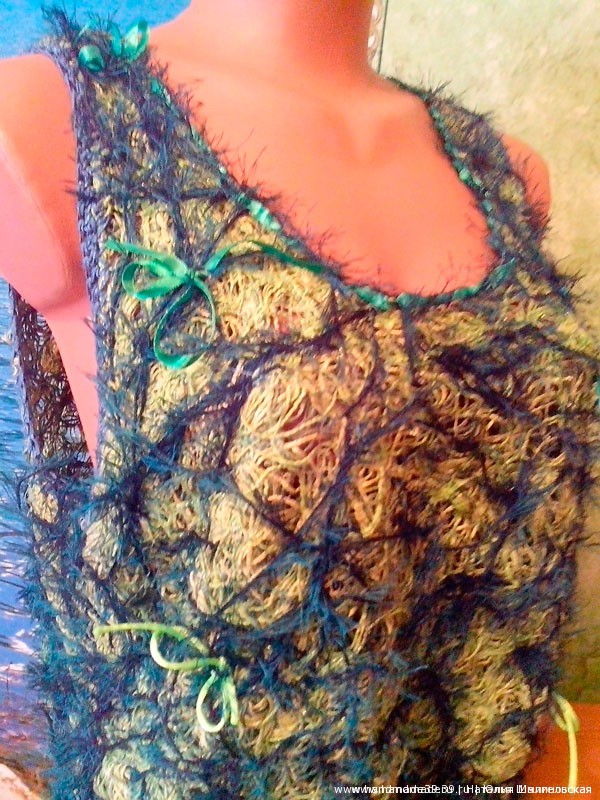 Top tunic “Forest”
Top tunic “Forest” Price 1700 rubles.
5. Tunic “Romance in Red”.
Size 44. The top of the tunic is knitted - loin mesh. The bottom is made using the Crazy Wool technique from gray yarn with lurex and red “grass”. Additionally, silk ribbons were used.
 Tunic for a romantic dinner with your loved one.
Tunic for a romantic dinner with your loved one. Price 1500 rubles.
Stoles and scarves
1. Stole “Blue Sea”
Crazy vul technique. Yarn: angora, mohair, wool for felting. Openwork, but at the same time very warm.
Looks chic with any outfit.
Can be repeated to order (any color scheme).
 Stole "Blue Sea".
Stole "Blue Sea". The price will depend on the width and length of the product.
2. Scarf “Fantasy”
Crazy vul technique. Material: angora, mohair.
Warm. Combines with clothes and hats of any color. An additional decorative element is a knitted flower.


Can be made to order (in any color scheme).
I am constantly learning, developing, and coming up with unusual clothes! Discovered for myself interesting technology sewing "crazy wool" - translated as "crazy yarn". I really like the fact that you can sew from threads, that is, combine sewing and knitting.There is a goal - to hone and sharpen your ability!




